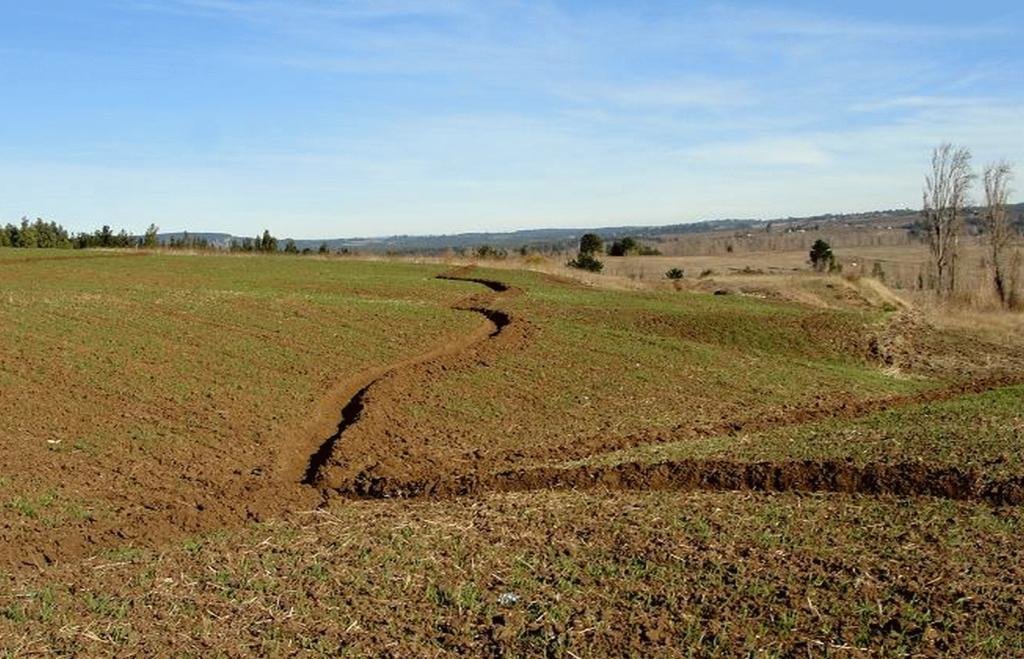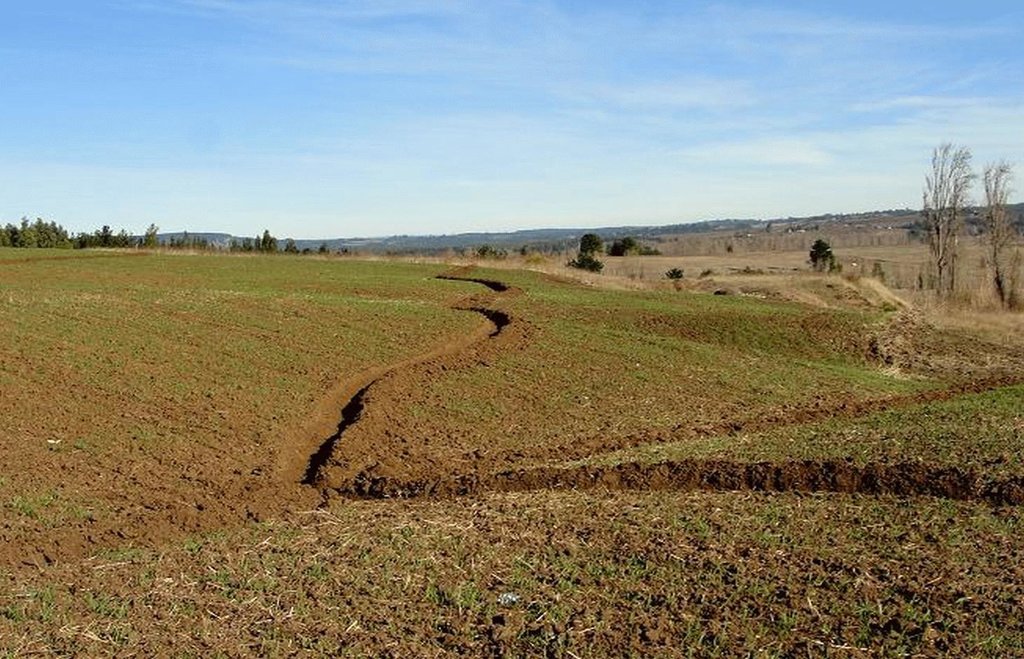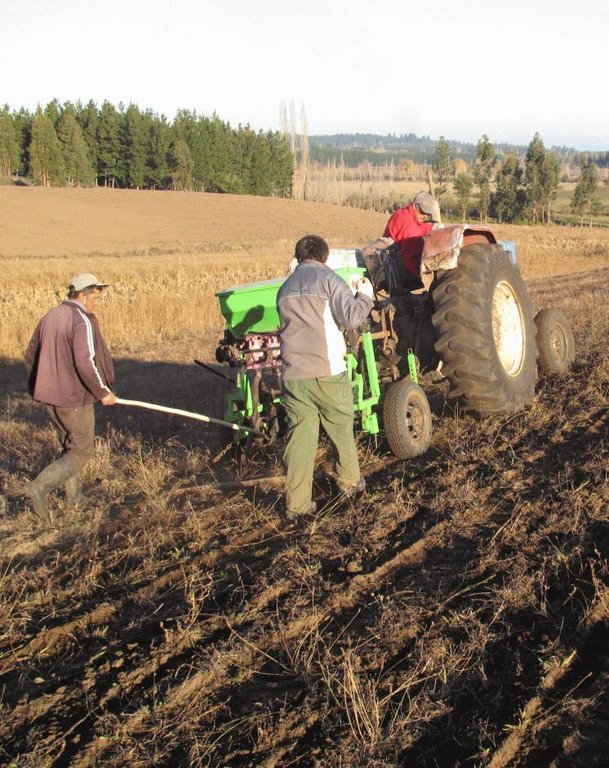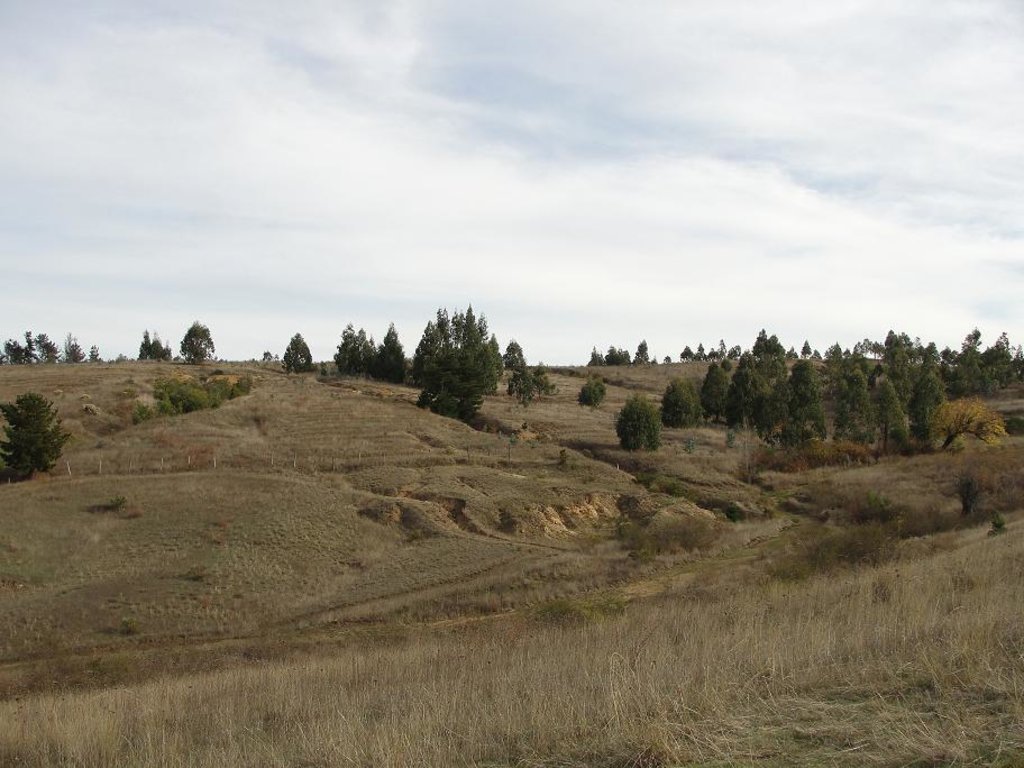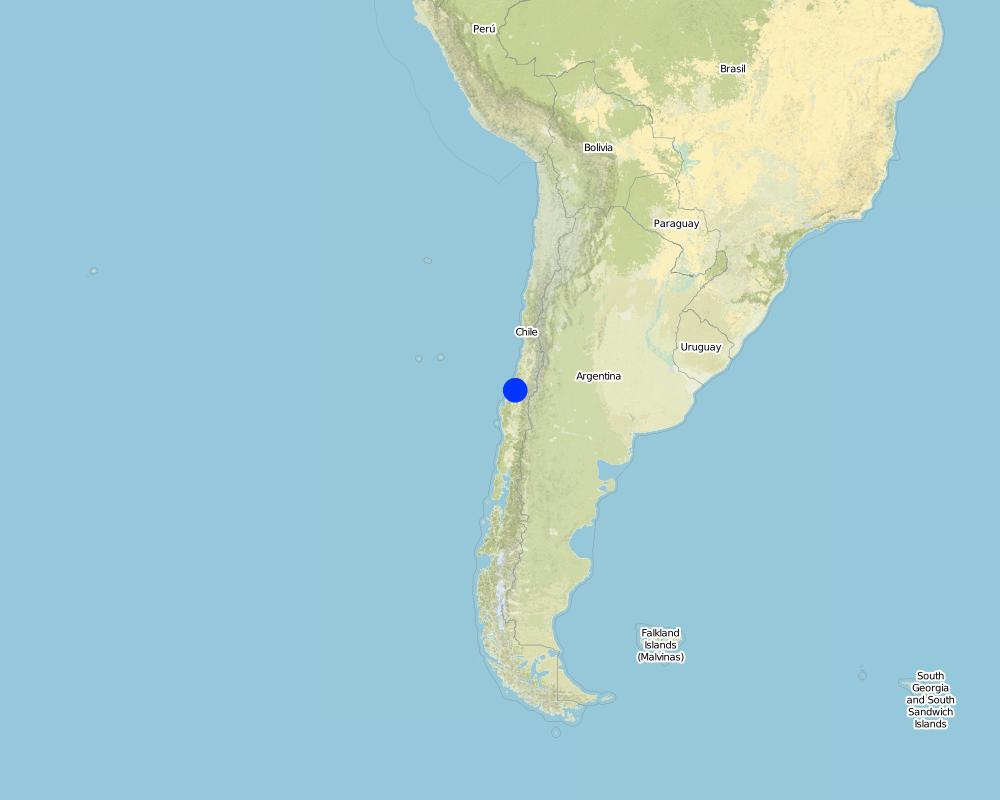Dissemination of soil conservation technologies in dryland areas [Chile]
- Criação:
- Atualização:
- Compilador/a: Carlos Ovalle
- Editor: –
- Revisor: Fabian Ottiger
Cero labranza con subsolado (Spanish)
approaches_2577 - Chile
Veja as seções
Expandir tudo Recolher tudo1. Informação geral
1.2 Detalhes do contato das pessoas capacitadas e instituições envolvidas na avaliação e documentação da abordagem
Nome da(s) instituição(ões) que facilitou(ram) a documentação/avaliação da Abordagem (se relevante)
Instituto de Investigaciones Agropecuarias (INIA) (Instituto de Investigaciones Agropecuarias (INIA)) - Chile1.3 Condições em relação ao uso da informação documentada através de WOCAT
Quando os dados foram compilados (no campo)?
11/05/2011
O/a compilador/a e a(s) pessoa(s) capacitada(s) aceitam as condições relativas ao uso de dados documentados através da WOCAT:
Sim
1.4 Referência ao(s) questionário(s) sobre tecnologias da GST
2. Descrição da abordagem de GST
2.1 Descrição curta da abordagem
Dissemination of no tillage with subsoiling in the Municipality of Yumbel
2.2 Descrição detalhada da abordagem
Descrição detalhada da abordagem:
Aims / objectives: The Commune of Yumbel is a rural territory in the secano interior of central-south Chile, which has historically been an area of cereal crops and pulses. This has represented for many years the mainstay of the economy of small and medium farmers in the area. Owing to the sharp deterioration in the quality of the soil, caused by years of cultivation without respect for conservation, production potential was quickly fading and plunging farmers into an economic and social crisis caused by low yields and low income from agriculture. However, despite degradation, the commune still has abundant natural resources of soil and water, which will not be used by the forestry industry, and which can be recovered for productive and profitable agriculture. In May 2009, the team of researchers from INIA Quilamapu started this initiative based on promising results obtained in the EU DESIRE project for zero tillage, subsoiling and new crop rotations. The initiative was oriented towards transferring the technologies developed in DESIRE. The project received financial support from the Municipality of Yumbel.
The aim was to revitalise agriculture in the district of Yumbel, improve traditional crops using a conservation approach, which enables small- and medium-scale farmers to improve their incomes, create jobs and improve their quality of life.
Specific objectives:
• To develop new farming systems based on the application of soil conservation practices (no tillage and subsoiling) that prevent erosion, and allow the development of a more sustainable and economic agriculture.
• To improve crop rotations, introduce grain and pasture legumes to diversify production and use of nitrogen inputs for lower nitrogen fertilizer costs.
• To build-up again the production of grain legumes and cereals in the district of Yumbel
• To renew the genetic material of crop species and varieties currently available to farmers in the area, allowing access to improved varieties of higher yield potential and resistance to diseases.
Methods: We used a participatory approach, incorporating small producers in the extension programme from the beginning. Three representative areas were selected. Leader farmers were chosen in each sector who were responsible for field work. No tillage machinery was provided by INIA and acquired by a local farmer. The project directly involved 50 farmers and 250 ha of land. Further 400 farmers are being benefited by training on technologies of soil conservation and crop rotations and management.
Role of stakeholders: Municiplity of Yumbel: financing the project of technology transfer INIA and DESIRE project: human and material resources (machinery, transportation researchers, etc.). Ministry of Agriculture (INDAP, Institute of Agricultural Development): financing of management plans for soil conservation.
Technology transfer companies: technical assistance directly to the small farmers
Farmers: conducting field work and incorporating new technologies.
2.3 Fotos da abordagem
2.5 País/região/locais onde a abordagem foi aplicada
País:
Chile
Região/Estado/Província:
Bíobio and Maule region
Especificação adicional de localização:
Cauquenes, Chile
Map
×2.6 Datas de início e término da abordagem
Indique o ano de início:
2007
Ano de término (caso a abordagem não seja mais aplicada):
2011
2.7 Tipo de abordagem
- Baseado em projeto/programa
2.8 Principais metas/objetivos da abordagem
The Approach focused on SLM only
To revitalising agriculture in the district of Yumbel, improve traditional crops with a conservation approach, which enables small- and medium-scale farmers to improve their incomes, to create jobs and to improve their quality of life.
The SLM Approach addressed the following problems: 1. Lack of machinery in the area 2. Few service providers 3. Lack of technical knowledge 4. Lack of cash to invest in SLM
5. Failure to implement a subsidy programme for farmers so that they can be organized around the creation of small company of service providers of machinery for subsoiling and no-tillage sowing.
2.9 Condição que propiciam ou inibem a implementação de tecnologia/tecnologias aplicada(s) segundo a abordagem
Normas e valores sociais/culturais/religiosos
- Inibitivo
The traditional farming system. Farmers have used the mouldboard plough as the primary tillage implement.
Treatment through the SLM Approach: Showing in farm days, the excellent results obtained in the experimental sites with no tillage and new crop rotation.
Disponibilidade/acesso a recursos e serviços financeiros
- Inibitivo
Lack of capital and financial resources of the farmers.
Treatment through the SLM Approach: State instruments and aids to implement soil conservation plans in the fields of the producers.
Quadro institucional
- Inibitivo
Absence or lack of coordination between institutions responsible for rural development.
Treatment through the SLM Approach: Implementation of a participatory rural development project for soil conservation and improvement of agriculture, inspired by the methodologies and experience of the project.
Conhecimento sobre GST, acesso a suporte técnico
- Inibitivo
Lack of knowledge on sustainable farming practices.
Treatment through the SLM Approach: Implementation of a soil conservation programme under the real conditions of the farmers with an environmental and economic sustainability approach.
3. Participação e papel das partes interessadas envolvidas
3.1 Partes interessadas envolvidas na abordagem e seus papéis
- Usuários de terra/comunidades locais
Men are more involved in tillage activities. Men perform hard labour job in the land, while women participate in household tasks.
- Especialistas em GST/ consultor agrícola
INIA
- Professores/alunos/estudantes
Universidad de Concepción, Universidad de Talca
- Governo nacional (planejadores, responsáveis pelas decisões)
INIA, SAG
- Organização internacional
3.2 Envolvimento do usuários de terra/comunidades locais nas diferentes fases da abordagem
| Envolvimento do usuários de terra/comunidades locais | Especifique quem estava envolvido e descreva as atividades | |
|---|---|---|
| Iniciação/motivação | Automobilização | The producers themselves and the municipality of Yumbel demanded the project implementation given the severe problems of rural poverty and the soil degradation |
| Planejamento | Participativo | The technologies are being applied and implementation has been made through interaction with farmers, municipalities, INIA and INDAP |
| Implementação | Participativo | The farmers implemented the conservation practice in their lands. |
| Monitoramento/avaliação | Participativo | Researchers evaluated this results |
| Research | Participativo |
3.4 Decisão sobre a seleção de tecnologia/tecnologias de GST
Especifique quem decidiu sobre a seleção de tecnologia/tecnologias a serem implementadas:
- Principalmente especialistas em GST, após consulta com usuários da terra
Explique:
Decisions on the method of implementing the SLM Technology were made by mainly by SLM specialists with consultation of land users
4. Suporte técnico, reforço das capacidades e gestão do conhecimento
4.1 Reforço das capacidades/ formação
Foi oferecida formação aos usuários da terra/outras partes interessadas?
Sim
Especifique quem foi capacitado:
- Usuários de terra
- Equipe de campo/consultores
Tipo de formação:
- Em exercício
- Agricultor para agricultor
- Áreas de demonstração
- Reuniões públicas
- Cursos
4.2 Serviço de consultoria
Os usuários de terra têm acesso a um serviço de consultoria?
Sim
Descreva/comentários:
Advisory service is very adequate to ensure the continuation of land conservation activities
4.3 Fortalecimento da instituição (desenvolvimento organizacional)
As instituições foram fortalecidas ou estabelecidas através da abordagem?
- Sim, moderadamente
Especifique a que nível (níveis) as instituições foram fortalecidas ou estabelecidas:
- Local
Dê mais detalhes:
The Yumbel project has had permanent participation of INIA (project DESIRE) and INDAP.
4.4 Monitoramento e avaliação
Monitoramento e avaliação são partes da abordagem?
Sim
Comentários:
bio-physical aspects were monitored by project staff through measurements; indicators: Soil fertility (soil nutrient content N, P, K, S), erosion (soil loss, loss of nutrients), quality of soil (compaction, bulk density, structure, aggregate stability)
economic / production aspects were monitored by project staff through observations; indicators: Crop production (yield, quality), gross margin, profitability
There were no changes in the Approach as a result of monitoring and evaluation
There were no changes in the Technology as a result of monitoring and evaluation
4.5 Pesquisa
A pesquisa foi parte da abordagem?
Sim
Especifique os tópicos:
- Tecnologia
Dê mais detalhes e indique quem realizou a pesquisa:
There are three experimental sites with evaluations to determine the best choice of conservation tillage systems and crop rotations. Different conservation tillage systems were evaluated and compared to conventional tillage. On these experimental sites, several indicators (chemical, physical and biological) were evaluated.
Research was carried out both on station and on-farm
5. Financiamento e apoio material externo
5.1 Orçamento anual para o componente de GST da abordagem
Caso o orçamento exato seja desconhecido, indique a faixa:
- 10.000-100.000
Comentários (p. ex. principais fontes de recursos/principais doadores):
Approach costs were met by the following donors: international: 30.0%; government: 70.0%
5.2 Apoio financeiro/material concedido aos usuários da terra
Os usuários da terra receberam apoio financeiro/material para a implementação de tecnologia/tecnologias?
Sim
Caso afirmativo, especifique tipo(s) de apoio, condições e fornecedor(es):
INDAP (Institute of Agricultural Development)
5.3 Subsídios para entradas específicas (incluindo mão-de-obra)
Se a mão-de-obra pelos usuários da terra foi uma entrada substancial, isso foi:
- Voluntário
Comentários:
Between INIA and Municipality of Yumbel a participative project wiht the local farmers was realized, to realize conservation tillage system.
The funding for the implementation of new technologies are 50% from the state (programme of recovery of degraded soils of the Government of Chile for soil conservation practices) and 50% of the producers themselves (materials, labour, etc.).
5.4 Crédito
Foi concedido crédito segundo a abordagem para atividades de GST?
Sim
Especifique as condições (taxa de juros, reembolso, etc):
repayment conditions: The funding for the implementation of new technologies are 50% from the state (programme of recovery of degraded soils of the Government of Chile for soil conservation practices) and 50% of the producers themselves (materials, labour, etc.).
6. Análise de impactos e declarações finais
6.1 Impactos da abordagem
A abordagem auxiliou os usuários da terra a implementar e manter as tecnologias de GST?
- Não
- Sim, pouco
- Sim, moderadamente
- Sim, significativamente
Mitigation of water erosion effects and better yields.
A abordagem concedeu autonomia aos grupos social e economicamente desfavorecidos?
- Não
- Sim, pouco
- Sim, moderadamente
- Sim, significativamente
This programme targets small farmers of the commune, who have no access to the technology or to State aid. The results are highly promising regarding the incorporation to the development of this sector.
Did other land users / projects adopt the Approach?
- Não
- Sim, pouco
- Sim, moderadamente
- Sim, significativamente
Because of the great results obtained by few farmers, the approach is being adopted by others.
Did the Approach lead to improved livelihoods / human well-being?
- Não
- Sim, pouco
- Sim, moderadamente
- Sim, significativamente
Farmers that perform conservation obtained better yields, less work on the sowing and more time to attend to other activities on the land.
Did the Approach help to alleviate poverty?
- Não
- Sim, pouco
- Sim, moderadamente
- Sim, significativamente
The improvement in yields and profitability of crops, the diversification of the production and the mitigation of land degradation are the strategies that are being implemented to alleviate poverty.
6.2 Principal motivação dos usuários da terra para implementar a GST
- Produção aumentada
- Lucro (lucrabilidade) aumentado, melhora da relação custo-benefício
- Carga de trabalho reduzida
- Pagamentos/subsídios
- normas e regulamentos (multas)/aplicação
- Prestígio, pressão social/coesão social
- Afiliação a movimento/projeto/grupo/rede
- Melhoria estética
6.3 Atividades de sustentabilidade de abordagem
Os usuários da terra podem manter o que foi implementado através da abordagem (sem apoio externo)?
- Incerto
6.4 Pontos fortes/vantagens da abordagem
| Pontos fortes/vantagens/oportunidades na visão do/a compilador/a ou de outra pessoa capacitada |
|---|
| Assistance programmes from the State oriented towards tackling soil degradation. (How to sustain/ enhance this strength: This project has been sustained over time and will remain at least for 3 to 4 years.) |
| High rural population in this commune, involvement of young farmers (under 40 years) |
| A strong commitment from the local authorities with the project. |
| Great interest of farmers to improve their incomes and conditions of life. |
6.5 Pontos fracos, desvantagens da tecnologia e formas de superá-los
| Pontos fracos/vantagens/riscos na visão do/a compilador/a ou de outra pessoa capacitada | Como eles podem ser superados? |
|---|---|
| Lack of no-tillage machinery | Organization of associative farmers enterprises for the purchase of machinery and agricultural implements. |
| Insufficient training on soil conservation for the farmers or for technical assistance companies. | Training, field days, demonstrative sowings, explanatory publications, practical work with farmers and technicians. |
| Delay in allocation of resources of the instruments of the state. | Synchronizing the availability of resources with the needs of the farmers for the execution of the work (supply purchases, rental equipment, etc.) |
7. Referências e links
7.1 Métodos/fontes de informação
- visitas de campo, pesquisas de campo
- entrevistas com usuários de terras
7.3 Links para informação relevante que está disponível online
Título/ descrição:
DESIRE site information
URL:
www.desire-his.eu/en/secano-interior-chile
Links e módulos
Expandir tudo Recolher tudoLinks
Não há links
Módulos
Não há módulos



